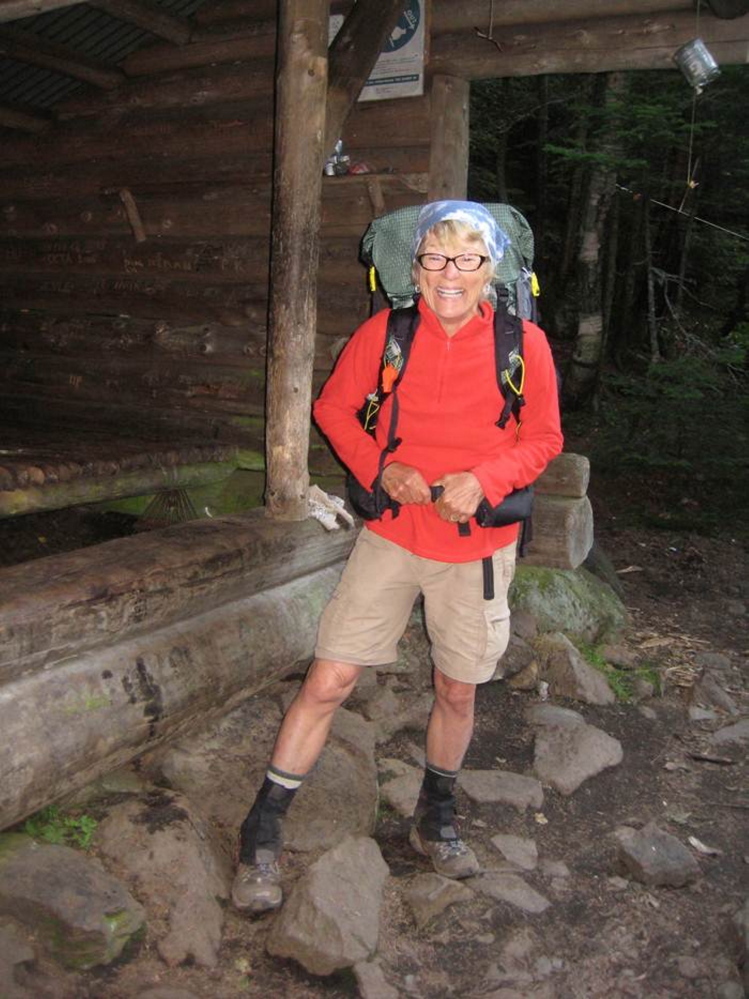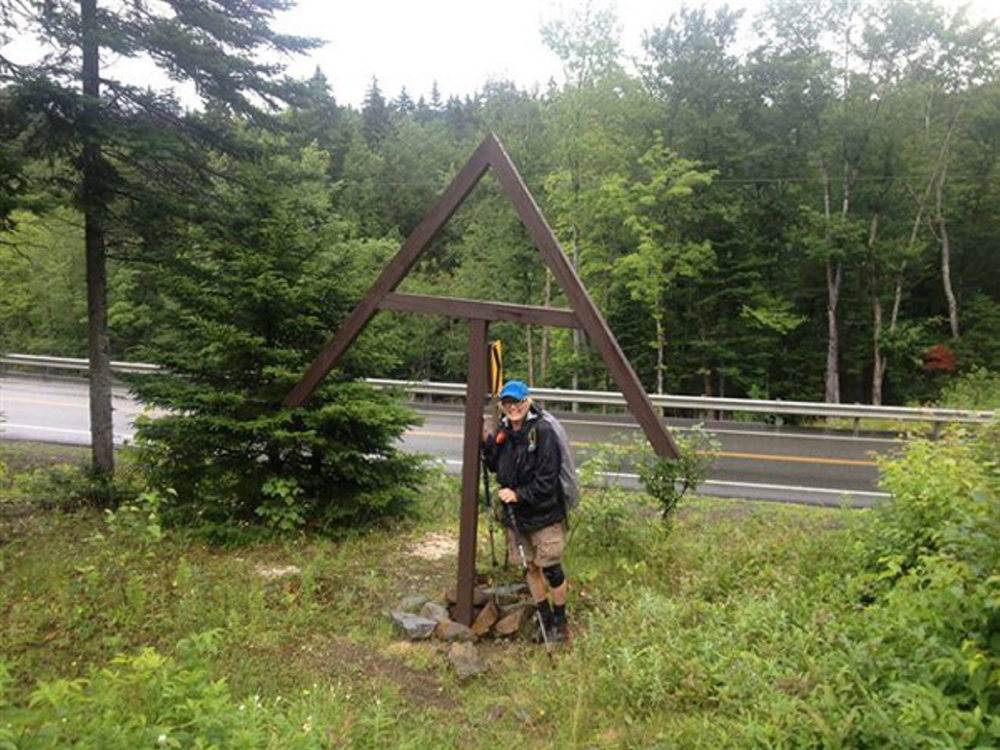A controversial Appalachian Trail expert who led the training course Geraldine Largay took before the thru-hiker got lost off the trail in 2013 and died in the woods says that the 66-year-old from Tennessee apparently did not follow his instruction to “go downhill and downstream.”
Warren Doyle, who is controversial within hiking circles because of his brash methods such as fording the Kennebec River and leading paid guided hikes along the trail, said he does not teach survival skills, such as how to make a fire or how to use a compass in his course, because getting off course on the trail is so rare. Largay took Doyle’s five-day course with hiking partner Jane Lee about a year before embarking on the journey.
“The whole thing with Gerry was a perfect storm, and in the history of the trail, a very unusual tale,” Doyle said in an interview.
But a warden service report on Doyle within the Largay 1,579-page case file raises questions not just about Largay’s preparedness for the challenging hike but also Doyle’s role in training her. Those questions come just over three years after Largay went missing without a trace. Next month will mark one year since her remains were found just a mile off the trail in the remote woods of Redington Township.
Despite the passage of time, and the release of the Maine Warden Service’s report on their investigation into her disappearance and their search efforts, Appalachian Trail experts — including Doyle — are still mystified with how she became lost off the well-marked 2,184-mile trail and was not found.
Investigators asked Doyle if he taught his students what to do should they become lost on the trail, and Doyle said he did not. In an interview with the Morning Sentinel, Doyle said he did cover how people get lost on the trail, and would tell students to retrace their steps, and if that failed, to go downhill and downstream.
“I wouldn’t say that’s teaching. I would say that’s common sense,” Doyle said. “But just because I share things with people doesn’t mean they listen.”
Doyle was also adamant that he would have told Largay, and any course he instructs, to go downhill and downstream and to not stay put unless they were unable to walk. Investigators would later learn that Largay walked toward high points in the woods after she got lost, trying unsuccessfully to send text messages from her cellphone to her husband.
“I would suggest as a cautionary tale for this whole thing, is not to be reliant on a cellphone and to question the advice that if you are not hurt that you should stay put — that you should make a cellphone call,” Doyle said.
In the report on Doyle, Maine Warden Service investigator Philip Dugas states that Doyle contacted authorities within the first week of the search for Largay, offering his expertise on where they should look for her, although Dugas states they had already searched the “obvious” locations he suggested. Dugas wrote that he asked Doyle for a copy of his course’s curriculum and Doyle said “he didn’t teach from a script.”
“There is no mention in any of Doyle’s material on his website regarding survival or skills such as fire building, lost person protocol or simple pathfinding direction,” Dugas wrote.
Largay, whose trail name was “Inchworm,” set out in April 2013 from Harper’s Ferry, West Virgina, with her friend and hiking partner Jane Lee to hike the northern half of the Appalachian Trail. The plan was to hike to the trail’s northernmost point, Mt. Katahdin in Baxter State Park, then go back to Harper’s Ferry, and hike south to Springer Mountain in Georgia, the trail’s southernmost point.
Along the way, Largay’s husband, George, would meet the duo where the trail intersected roads, replenishing their supplies and bringing them to motels for the night, and dropping them back off at the trailhead the next morning.
But after Lee had to leave the trip because of a family emergency on June 30, 2013, Largay decided to finish the Maine stretch of their hike alone. Then, the plan began to unravel.
On July 24, George Largay reported his wife missing after she failed to appear where the trail crossed Route 27 the prior day, setting off a massive search effort led by the Maine Warden Service. Her fate would not be known until October 2015 when a contractor working for the U.S. government found her remains and a campsite she had set up after becoming lost on land owned by the Navy — just under a mile from the trail.
When the warden service eventually released its 1,579-page case file on the Largay investigation in May this year, Largay was revealed to have gone off the trail to use the bathroom on July 22, about two to three miles from where she was last seen at the Poplar Ridge lean-to.
Throughout the case file there are numerous red flags that Largay was in over her head to set out on the AT journey alone. Interviews that warden service investigators conducted with Lee contain several mentions of Largay becoming disoriented on the trail when they were hiking together. The case file also revealed that Largay did not know how to use a compass and relied heavily on her cellphone rather that utilizing lost-hiker logic.
While Largay was touted as an experienced hiker while she was missing, and in the wake of her remains being found, Appalachian Trail experts say that thru-hiking the trail is at a different level than 20-mile day hikes, and it takes an immense amount of mental self awareness and common sense.
“I suspect that Geraldine overestimated her skills and underestimated the danger in Maine,” said Ray Ronan, a Maine Appalachian Trail Club member and editor of the club’s guidebook, in an interview.
‘SHE WAS A SPONGE’
Largay and Lee participated in Doyle’s five-day Appalachian Trail Institute preparation course in the fall of 2011 or the spring of 2012, Doyle said in a phone interview this week.
Warden service investigator Lt. Kevin Adam, the lead investigator on the Largay case, said that Largay had also taken a course with a woman who had completed the trail in record time, though Adam did not recall the woman’s name when asked this week.
Doyle said his course includes classroom instruction time along with three 5- to 7-mile day hikes. He said the main goal of this course is instilling hikers with the philosophical and psychological aspects of long distance hiking. Often people complete the course and realize that a thru-hike may not be the right decision for them, he said.
Doyle does not teach from a curriculum, but rather he teaches what he has learned through his 17 thru-hikes of the trail.
A two-page booklet on his website titled “Walking the Entire Appalachian Trail: Fulfilling a Dream by Accomplishing the Task,” summarizes his “points of wisdom” about hiking the trail, along with facts about the trail, The book shines light on the fact that his course was centered around a psychological preparation for hiking the trail.
“The Trail knows neither prejudice nor discrimination. Don’t expect any favors from the Trail. The Trail is inherently hard. Everything has to be earned. The Trail is a trial,” one bullet point of the booklet reads.
Doyle said he remembers Largay as eager to learn. After completing the course, Largay and her husband decided she would day-hike the trail, rather than backpack it, he said. Doyle met with them after the course, and prior to their departure on the thru-hike in 2013, to discuss where the trail intersects with roads so they could plan how George Largay would support Lee and Largay.
“She was a sponge,” Doyle said of Largay. “She wanted to learn a lot; she wanted to be prepared.”
GETTING OFF TRAIL
In preparation for their hike, during the summer of 2012, Lee and Largay hiked together, according to an interview between Lee and Dugas that is included in the warden service case file. However, Lee told Dugas that between 2012 and 2013 she had noticed a change in Largay’s hiking. Lee said Largay was “slower, less steady, purposeful, deliberate and more careful.”
Lee disclosed that on several occasions during their hike of the trail, Largay would become disoriented and begin hiking in the wrong direction. Lee said Largay would become “flustered and combative when she made these kind of mistakes.”
Largay was scared of the dark, of being alone, that she had a lack of confidence and was not able to cope with the obvious rigors of the trail, according to Dugas’s interview with Lee.
“If she got as far north as Maine and mental issues were playing, that plays on a long distance hiker completely,” said Craig Dickstein, Maine AT club member and trail overseer of the Kennebec District, in an interview.
Lee told Dugas she and George Largay were worried when it become apparent that Lee had to leave the trip; however, Lee said George Largay was unaware of the extent of his wife’s struggles on the trail.
When George Largay left his wife at Piazza Rock on the trail on July 21 — the last time he would see her — she told him that the trail was getting harder, according to the report.
While on the trail, Largay would keep in contact with her husband via cellphone. On July 22, she attempted to send a text to him stating that she had left the trail to go to the bathroom and she had become lost. Due to poor cellphone service, the message did not go through and she would attempt to send it 10 times over the next hour and a half, according to a cellphone examination by the Maine Computer Crime Lab completed Oct. 20.
“There are all skill levels out there, and if she had poor sense of direction, smarts would have suggested she shouldn’t leave the trail,” Dickstein said. “Even if you have to pee, if you’re not comfortable with leaving the trail, don’t leave the trail.”
It is not known how far off the trail Largay walked to use the bathroom. In her interview with investigators, Lee said Largay would not leave the trail to urinate and would only go off trail about 100 feet, leaving her pack on the trail.
But Largay did not leave her pack on the trail on the morning of July 22 when she went off trail.
Largay kept a journal during the time leading up to her death while lost in the woods. The report said that in her own words, Largay left the trail after crossing Oberton Stream. Unable to find her way back to the trail, she spent the next day or two wandering west of the trail, hiking ridge to ridge.
“If you’re going off the trail … you have to use common sense an keep your bearing,” Ronan said. “Obviously she didn’t do that.”
COMMON SENSE
Appalachian Trail experts say that leaving the trail and getting lost is incredibly difficult to do given the frequency of white blazes that mark the trail and how frequently traveled it is.
“On the AT, it’s not easy to get lost. It isn’t easy to get off the trail. It’s a very well beaten down foot path,” said Ron Dobra, a Maine AT club member and overseer of the Whitecap District, in an interview.
Every year, about 28 hikers become lost off the Appalachian Trail in Maine, Adam said shortly after Largay was reported missing. In those cases, 95 percent of the time searchers find the missing hikers within 12 hours, and within 24 hours 98 percent are found.
The warden service’s extensive search for Largay was launched the day after she was reported missing by her husband on July 24. On Aug. 4, 2013, the search was scaled back, though it continued grid searches and searches with trained dog teams up until the time her remains were found on Oct. 14, 2015.
Dates marked in Largay’s journal showed she was alive as late as Aug. 6, possibly later. A journal entry is dated Aug. 18, though it is not clear if that is accurate. The journal was found with Largay’s remains at the campsite she had set up after becoming lost. She died zipped in her sleeping bag from a lack of food and water, according to the medical examiner’s report, released in January.
Adam said that no tactic of finding your way back to the trail is going to be 100 percent effective. He said the warden service maintains that the first thing a hiker should do when they become lost is to stay put and find the most open area they can. Adam said that once a lost hiker finds open area, they should try to signal for aircraft using a fire.
Adam’s report states that scorch marks on several trees around the area of Largay’s campsite appear to be evidence of Largay attempting some type of fire. A silver space blanket was also found tied to branches that were located in area that had a 25 by 25 foot radius of some open canopy.
However, he said there was no evidence of a fire ring at the campsite, despite there being downed dead fir trees around that campsite that would have been a source of burnable material.
Adam urges hikers to make a fire and keep it going. If an aircraft flies overhead and does not come back and stay with you, they most likely did not see you, he said. In this instance, as well as if no aircraft has flown over in several days, Adam said a hiker should possibly consider moving.
Though deciding when to move and employ other tactics for being found is a difficult decision to make.
“How long to stay put is a great question. That’s a personal question,” Dickstein said.
Both Dickstein and Ronan said this is where map and compass skills come into play, which they both considered common sense for people embarking on the trail.
While a map and compass was found at Largay’s campsite, she did not know how to use the compass, according to the warden service report. There is no evidence in the case report of Largay attempting to leave her location once she set up camp.
“I was really kind of appalled that she wasn’t more proactive in trying to find some way out,” Ronan said. “She just kind of gave up.”
Doyle, though, said a compass is unnecessary for hiking the AT, and that walking downhill and downstream will lead hikers to larger streams and possibly a road.
Adam maintained that there are drawbacks to using the “downhill and downstream” approach such as following a stream to a large bog. However, he said if no aircraft is seen within several days, a hiker should employ that approach to find a more open area.
If lost, hikers should also do away with the “leave no trace” theory. Adam suggests that if a hiker has paper, they should write the date, time, and their name and leave the notes hanging from tree branches.
“If nothing else Geraldine — ‘Inchworm’ — is putting it out there as a cautionary tale, she is raising awareness,” Ronan said.
Lauren Abbate — 861-9252
Twitter: @Lauren_M_Abbate
Copy the Story LinkSend questions/comments to the editors.





Success. Please wait for the page to reload. If the page does not reload within 5 seconds, please refresh the page.
Enter your email and password to access comments.
Hi, to comment on stories you must . This profile is in addition to your subscription and website login.
Already have a commenting profile? .
Invalid username/password.
Please check your email to confirm and complete your registration.
Only subscribers are eligible to post comments. Please subscribe or login first for digital access. Here’s why.
Use the form below to reset your password. When you've submitted your account email, we will send an email with a reset code.